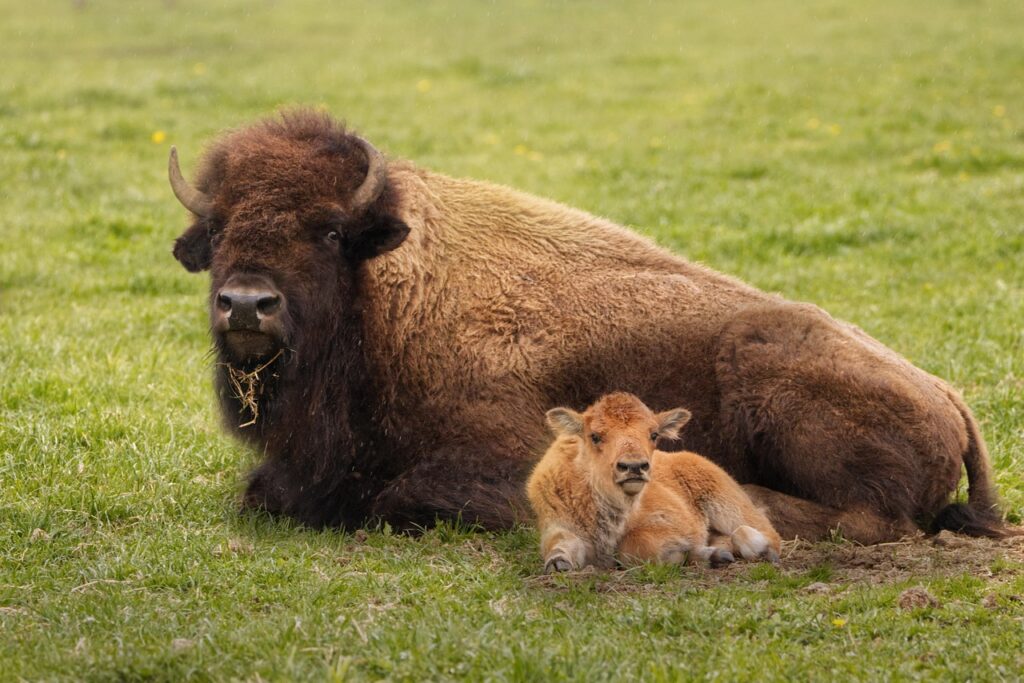
By Amelia Thayer, S25 Environmental Clinic Student
INTRODUCTION
Long before European contact, Native American tribes relied on the buffalo[1] for a significant portion of their food, clothing, and tools. The bond between the Lakota Nation and Tataŋka (the buffalo) is sacred. Buffalo have cared for the Lakota people for millennia, providing much of what they needed for their way of life. The buffalo has profound spiritual significance in Lakota culture; the buffalo are their family members. Bringing buffalo back to the Great Plains is a significant step toward food sovereignty and cultural revitalization for the Lakota people.
THE BUFFALO IN NORTH AMERICA
Bison are the largest land mammal in North America. Once, up to 60 million bison traveled the continent. They were essential to many Native American tribes’ ways of life. In the late 1800s, the American government recognized the value of bison fur trading as well as the significance of the bison to the Indigenous people. Hunting the bison for sport or for their fur would reduce the number of bison that Native Americans could harvest, eliminating a major food source and helping force Native Americans onto reservations. Bison were nearly to extinction by the 1900s. In 1905, there were only twenty-three wild bison remaining, living in what is now Yellowstone National Park.
FOOD SOVEREIGNTY
Food sovereignty is important to many Native American nations. Clay Colombe, the CEO of the economic development arm of the Sioux Nation, said: “Our Lakota ancestors have been fighting for generations to overcome this disruption to our food system and mass extraction of wealth from our community.”[2]
The Siċanġu Nation, one of seven Lakota nations, is working towards food sovereignty on the Rosebud Indian reservation in south central South Dakota. The Reservation covers almost 2,000 square miles, has a population of about 26,000, and has only three grocery stores. In contrast, Marshalltown, Iowa, has a population of about 27,000 people and nine grocery stores.
The Siċanġu Nation set up the Siċanġu Harvest Market to increase its community’s access to traditional and healthy foods. The Tribe is also working to develop menus at the tribal school that emphasize traditional foods and agricultural methods. Brandi Charging Eagle, a member of the Siċanġu Nation, told the Guardian: “They’re here to teach us how to be food sovereign because someday, food is going to get too expensive for our people. The prices of food are going up, but our wages aren’t.”[3]
BRINGING THE BUFFALO BACK
The return of buffalo to the Rosebud Indian reservation is an important step forward in food sovereignty for the Siċanġu Nation. The reservation’s Wolakota Buffalo Range is now home to over one thousand buffalo. It is currently the largest Native American-owned bison herd in the world. In 2024, two buffalo from the nation’s herd were donated to the school. That meat replaced 75% of the red meat that the school would have otherwise procured to serve at mealtime. This effort allows the young students to learn about and eat culturally significant foods, an important step in protecting Siċanġu culture.
Bison are also better for the environment than cows. Bison spend 26-28 percent of their time grazing, graze on a large variety of grasses and plants, and roam more as they graze, leaving many areas untouched. Cattle spend 45-49 percent of their time grazing, prefer flowering herbs, and will graze one area until it is depleted. While cattle trample the soil and damage the soil curst, bison walk with a lighter gait and turn the soil over more effectively. Bison also roam further from water sources and do not trample stream banks or pollute streams like cattle do.
CONCLUSION
Bringing the buffalo back home to the range is an important first step towards addressing many of the harms that have been inflicted on Native American tribes and the environment over the course of U.S. history. The benefits include regenerating the Plains ecosystem, where bison have long played an important role, increasing tribal food sovereignty, and allowing generations of Siċanġu people to reconnect with their ancestry.
References:
Civil Eats, Meet The Group That’s Been Bringing The Bison Back To Tribal Lands For 30-Years (July 2022).
Siċanġu Co., Tataŋka ki iċiċu: The Gift of Buffalo.
Ozark Valley Bison Ranch, The Majestic North American Bison.
Rockefeller Found., 7Gen Food System.
Native Hope, Sioux Native Americans: Their History, Culture, and Traditions (Aug. 2021).
World Wildlife Fund, Rosebud Sioux Tribe Welcome First Bison Home to Wolakota Buffalo Range (Oct. 2020).
Devatha P. Nair, Cattle Ranching is Actually Terrible for Biodiversity, Sentient Climate (Oct. 13, 2022).
[1] Bison is the scientific name, but buffalo is used by many Indigenous groups.
[2] https://pressroom.toyota.com/bringing-back-the-bison-the-wolakota-buffalo-range-project/
[3] Grace Hussain, Western Food was Unhealthy and Costly. So They Turned Back to Bison and Mushrooms, Guardian, (Feb. 8, 2025, 11:00 AM) https://www.theguardian.com/environment/2025/feb/08/south-dakota-native-food.
